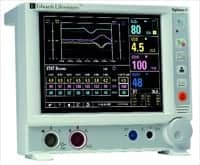How the DR sector is propelling a new standard of care
By Elaine Sanchez Wilson
As x-ray film moved to computed radiography (CR), patients and providers saw tremendous benefits from the resulting enhanced image quality and speed of imaging results. After all, the technology eliminated the likelihood for reshooting an image, therefore lessening the exposure to additional ionizing radiation, reducing costs, and streamlining diagnosis. Later, the advent of digital radiography (DR) ushered in further improvements to image quality, speed, and dose efficiency.
Fast-forward 40 years and the federal government has thrown its support behind the technology, reducing Medicare reimbursement for film-based exams by 20% this year. Next year, organizations can expect additional cuts for studies performed on CR equipment.
Today, approximately 35 million chest x-rays are performed each year in the United States. “That would be a lot of film today, and even though the price of film has dropped significantly, there is a cost assigned to it,” points out Guillermo Sander, senior strategic marketing manager for the Americas at Wayne, N.J.-based Konica Minolta Healthcare Americas Inc.
“DR is helping to drive improvements in the cost of healthcare; while digital imaging incurs some expense, the elimination of film delivers significant cost-savings to the hospital in terms of equipment and space to store films.”
Technology Transformed
According to Lori Webb, BAAS R.T.(R), product line advisor at Boca Raton, Fla.-based Virtual Imaging Inc., a Canon company, DR has come a long way since its earliest generation. Decades ago, larger hospitals, university teaching sites, and busy clinics were the primary institutions that could afford the technology over analog systems. “Then, as more players came into the market, the cost of the systems went down,” Webb recalls. “Over time, the equipment manufacturers and vendors were able to find ways to produce digital radiography components at lower costs and become more efficient in their production of the units.”
When Rochester, N.Y.-based Carestream Health introduced the industry’s first wireless, cassette-sized detectors in 2009, for instance, the company sought to improve patient positioning and ease of use. The new generation of detectors also offered better image quality, greater reliability, and faster capture speeds, says Cheryl McCarron, Carestream’s regional business manager of x-ray solutions for the U.S. and Canada.
“This gives physicians faster access to diagnostic information and expedites patient care,” McCarron says. “The ability to add advanced applications, such as tomosynthesis and dual energy, are also important enhancements.” And thanks to advanced software applications, clinicians can use x-ray to do more than acquire a static image.
To Konica Minolta’s Sander, a new realm for x-ray is just beginning. A decade ago, for example, tomosynthesis was cumbersome and not easy to use.
“Today with direct digital, it delivers the rapid sequence of images that makes the technology clinically useful,” Sander says. “Emerging image processing technologies, such as bone suppression for separating soft tissue from bone, are designed to deliver new or additional diagnostic information to the physician. And there are other tools under development that allow us to use x-ray in a new, more dynamic way, including the ability to quantify data from the x-ray image and use that information to accelerate the time to diagnosis and improve clinical confidence.”
Such innovations are perhaps not surprising, considering how far technology has come in the past decades. Just look at how much acquisition sites have improved since their early-’90s introduction, mantains Dave Bauerle, vice president of business development at Alachua, Fla.-based The InterMed Group. “Using advanced algorithms, techs are able to use less radiation to obtain the same image detail and quality,” he says. “And in my opinion, lowering the doses is one of the most valuable things we can do for our customers.”
Making Informed Purchasing Decisions
In the past, radiology department leaders, such as radiologists, radiology administrators, and chiefs of radiology, typically were the key decision-makers—often with some input from technologists, Sanders says. However, changes in the healthcare environment and technology have brought the finance and information technology departments into the equipment acquisition process.
“Today, IT captures data points from multimodality devices and aggregates it,” Sander says. “Equipment and solutions are not viewed as standalone systems, rather they need to communicate with other systems and devices.” Remote management of assets and information is an important task. “IT is now a tool of the physician, the hospital administrator, and the biomed,” Sander continues. “Therefore, the department and its leaders have become a primary customer in the sales cycle.”
Just as the personnel involved in the selection process has shifted, so too has the types of facilities interested in purchasing the technology. “We expect expanding opportunities for DR systems in all market segments, from large integrated delivery networks to single-clinician practices,” says Carestream’s McCarron. “
She adds that the company’s DRX Core product line is suited for a range of providers, from small to mid-size imaging centers and physician practices, to chiropractors. According to McCarron, the key benefits of these devices include Carestream’s ability to register every DRX detector with all DRX portable and room-based systems, as well as the company’s experience in retrofitting more than 100 different analog systems to DR, thereby lengthening the lifespan of existing capital equipment.
Similarly, Konica Minolta provides a range of x-ray systems optimized for multiple environments, including smaller outpatient facilities, according to Sander. The company’s KDR AU System Advanced U-Arm, for instance, can move from posterioranterior to lateral positions without moving the patient—and further saves time by automatically swiveling into position across a 135° range of motion and 35 inches of vertical movement.
Adding her company’s name to the discussion, Webb says Canon sets itself apart by offering extra software features at no extra charge. “We found that some of our competitors actually charge a little bit more for various software functionality, but Canon has included some of these features into one offering and not charged additional monies,” she says.
Bauerle, however, chalks up some differences to marketing, saying that’s today’s manufacturers offer very similar products with very similar price tags. As facilities make their purchasing decisions, they should consider a number of factors, he says—for example, whether they want fixed, tethered, or wireless panels (“This is all buyer-preference and has no effect on the quality of the image,” he says) or what style of detector. (“Gadox,” he says, “is the lower cost standard, with cesium being the higher quality”).
Protecting Your Assets
From a technology standpoint, DR systems are becoming increasingly motorized—and complex. To McCarron, such innovations signal progress, although she acknowledges that some challenges exist.
Ergonomics are improved, which is beneficial to technologists, but it means that systems and detectors now use motorization, sensors, interlocks, and other advanced technology,” McCarron says. “This raises the bar for biomeds who service these systems and must ensure that both DR systems and detectors from one or more suppliers interface smoothly into a provider’s IT network.”
And now more than ever, DR systems are reliant on computers and software. “Many issues today are from software—including updates/upgrades to third-party software such as virus protection or the operating system,” Sander says. “That requires a different skill set than mechanical [work]—and troubleshooting often becomes more complex.”
Another major challenge that HTM professionals face is that not much can be done if a panel gets damaged, Bauerle says. That’s why he encourages healthcare personnel to exhibit a great deal of care when handling DR equipment. “Outside of that, if it breaks, it will need to be replaced in most situations.” Fortunately, Bauerle says, facilities are able to purchase additional warranties—as well as drop coverage—due to their specific needs and expected level of use. “These options should definitely be considered at the time of purchase,” he adds.
Webb concurs, pointing out that some radiology departments even require technologists to sign contracts acknowledging the proper handling of expensive detectors. Plus, health providers may purchase a special protection plan, an insurance rider, or a service program that protects detectors from accidental drops and fluid spills to help cover their investment.
Her top piece of advice for facilities, however? Follow best practices regarding the proper use and care of flat-panel detectors and take advantage of vendor-offered courses for tailored training. She also advises departments to be consistent with preventive maintenance and perform software updates and upgrades when they are prompted. And, finally, Webb stresses the importance of open channels of communication between healthcare facilities and their equipment vendors.
Such advice is particularly relevant to HTM professionals—who, McCarron says, are tasked with delivering continuous uptime, in addition to assisting with the request-for-proposal process and determining the total cost of ownership.
“In order to help accomplish those goals, it’s important to work with a supplier that has a service partnership program that offers customers varying levels of support depending on the type of biomed coverage that customers want to provide,” she says. “Facilities that have biomeds performing their own system repairs should equip them with the same training as the supplier’s service engineers so they’re experts on each DR system.”
Buyers can also take advantage of systems that come equipped with features to expedite troubleshooting, such as Konica Minolta’s AeroRemote. In fact, Sander says, the cloud-based, real-time monitoring service detects and reports critical and ongoing performance metrics and issues—from drop detection to component performance.
Looking to the Future
Despite all of the innovations the DR sector has seen as of late, even more progress is slated for the future. Webb, for one, envisions a future with even more advanced software applications. “We will continue to see the physical characteristics of the flat panels evolve,” she says. “We may see different sizes and shapes of DR panels made available to consumers, along with fused or hybrid imaging like we have seen within the modalities of CT, MRI and PET.”
Webb also sees the potential for exploring new options in how DR panels are manufactured. “Carbon fiber is something that we use now at Canon,” she says, adding that companies are considering how “to make things lighter, more water-resistant, sturdier, less costly, and anti-microbial, since infection control is an important issue in hospitals today.”
On a related note, Carestream is in the process of developing a portable DR system that uses carbon nanotube technology, with a goal of launching a system that is more compact and lighter-weight to expedite bedside imaging in crowded critical-care areas. The company is also making a significant investment to enhance the durability of its DR equipment, McCarron says. “This includes making detectors that are able to withstand drops without damage and offering the highest IPX rating available against liquid ingress,” she continues.
To Sander, DR is undergoing an evolution in functional imaging. Responding to this trend, Konica Minolta is exploring new ways to derive more information from the digital data that DR acquires. “There is untapped opportunity in DR,” Sander says. “We don’t yet know where this will take us, but we believe x-ray will find new avenues of clinical usefulness, and I suspect my expectations will be exceeded.”
But perhaps Bauerle sums it up best: “DR is the future,” he says. “With [Centers for Medicare & Medicaid Services] reimbursements penalized for the use of outpatient wet film and for CR facilities, DR will be the new standard. Furthermore, we can expect the software to continue to evolve, bringing faster and higher-quality imaging.” In other words, the future for DR is bright, indeed.
Elaine Sanchez Wilson is associate editor of 24×7 Magazine. For more information, contact [email protected].






Drop and damage insurance protections are available but they come with at a pretty steep price. For wireless detectors we sell I always emphasize the importance of careful handling, let my customers know of the various insurance policies available to them and encourage them to purchase protective shells for non bucky exams and drop protective shells and or soft floor padding around wall buckies and table buckies where the wireless panels are inserted into and extracted from their panel holding devices.
Rapid X-Ray
OEM Quality @ Non OEM Prices
https://www.rapidxray.biz